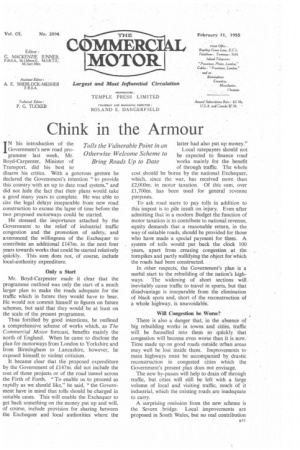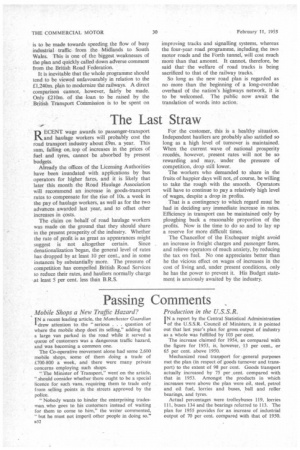Chink in the Armour
Page 39

Page 40

If you've noticed an error in this article please click here to report it so we can fix it.
IN his introduction of the Government's new road pro gramme • last week, Mr. Boyd-Carpenter, Minister of Transport, did his best to disarm his critics. With a generous gesture he declared the Government's intention "to provide this country with an up to date road system," and did not hide the fact that their plans would take a good many years to complete. He was able to cite the legal delays inseparable from new road construction to excuse the lapse of time before the two proposed motorways could be started.
He stressed the importance attached by the Government to the relief of industrial traffic congestion and the promotion of safety, and aRnounced the willingness of the Exchequer to contribute an additional £147m. in the next four years towards works that could be started relatively quickly. This sum does not, of course, include local-authority expenditure.
Only a Start Mr. Boyd-Carpenter made it clear that the programme outlined was only the start of a much larger plan to make the roads adequate for the traffic which in future they would have to bear. He would not commit himself to figures on future schemes, but said that they would be at least on the scale of the present programme.
Thus fortified by good intentions, he outlined a comprehensive scheme of works which, as The Commercial Motor forecast, benefits mainly the north of England. When he came to disclose the plan for motorways from London to Yorkshire and from Birmingham to Lancashire, however, he exposed himself, to violent criticism.
It became clear that the proposed expenditure by the Government of £147m. did not include the cost of those projects or of the road tunnel across the Firth of Forth. "To enable us to proceed as rapidly as we should like," he said, "the Government have in mind that tolls should be charged in suitable cases. This will enable the Exchequer to get back something on the money put up and will, of course, include provision for sharing between the Exchequer and local authorities where the latter had also put up money."
Local ratepayers should not be expected to finance road works mainly for the benefit of through traffic. The whole cost should be borne by the national Exchequer, which, since the war, has received more than £2,000m. in motor taxation. Of this sum, over £1,700m. has been used for general revenue purposes.
To ask road users to pay tolls in addition to this impost is to pile insult on injury. Even tfter admitting that in a modern Budget the function of motor taxation is to contribute to national revenue, equity demands that a reasonable return, in the way of suitable roads, should be provided for those who have made a special payment for them. A system of tolls would put back the clock 100 years, apart from creating congestion at the turnpikes and partly nullifying the object for which the roads had been constructed.
In other respects, the Government's plan is a useful start to the rebuilding of the nation's highways. The widening of short sections will inevitably cause traffic to travel in spurts, but that disadvantage is inseparable from the elimination of black spots and, short of the reconstruction of a whole highway, is unavoidable.
Well Congestion be Worse?
There is also a danger that, in the absence of big rebuilding works in towns and cities, traffic will be funnelled into them so quickly that congestion will become even worse than it is now. Time made up on good roads outside urban areas may well be lost inside them. Improvements to • main highways must be accompanied by drastic reconstruction in congested cities which the Government's present plan does not envisage.
The new by-passes will help to drain off through traffic, but cities will still be, left with a large volume of local and visiting traffic, much of it industrial, which the existing roads are inadequate to carry.
A surprising omission from the new, scheme is the Severn bridge. Local. Improvements are proposed in South Wales, but no real contribution is to be made towards speeding the flow of busy industrial traffic from the Midlands to South Wales. This is one of the biggest weaknesses of the plan and quickly called down adverse comment from the British Road Federation.
It is inevitable that the whole programme should tend to be viewed unfavourably in relation to the £1,240m. plan to modernize the railways. A direct comparison cannot, however, fairly be made. Only £210m. of the loan to be raised by the British Transport Commission is to be spent on improving tracks and signalling systems, whereas the four-year road programme, including the two motor roads and the Forth tunnel, will cost much more than that amount. It cannot, therefore, be said that the welfare of road tracks is being sacrificed to that of the railway tracks.
So long as the new road plan is regarded as no more than the beginning of a long-overdue overhaul of the nation's highways network, it is to be welcomed. The public now await the translation of words into action.
















































































































